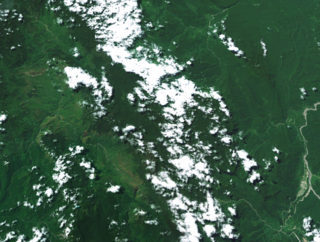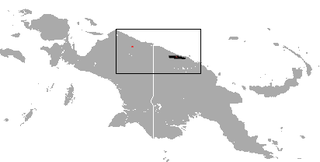
Kaiser-Wilhelmsland formed part of German New Guinea, the South Pacific protectorate of the German Empire. Named in honour of Wilhelm I, who reigned as German Emperor from 1871 to 1888, it included the northern part of present-day Papua New Guinea. From 1884 until 1920 the territory was a protectorate of the German Empire. Kaiser-Wilhelmsland, the Bismarck Archipelago, the northern Solomon Islands, the Caroline Islands, Palau, Nauru, the Northern Mariana Islands, and the Marshall Islands comprised German New Guinea.
Highlands or uplands are areas of high elevation such as a mountainous region, elevated mountainous plateau or high hills. Generally, upland refers to a range of hills, typically from 300 m (980 ft) up to 500–600 m (1,600–2,000 ft), while highland is usually reserved for ranges of low mountains. However, the two terms are sometimes interchangeable.

The German New Guinea Company was a German Chartered Company which exploited insular territory in and near present Papua New Guinea.

Adelbert Range is a mountain range in Madang Province, north-central Papua New Guinea. The highest point of the mountains is at 1,716 metres (5,630 ft).

Mount Wilhelm is the highest mountain in Papua New Guinea at 4,509 metres (14,793 ft). It is part of the Bismarck Range and the peak is the point where three provinces, Chimbu, Jiwaka and Madang, meet. The peak is also known as Enduwa Kombuglu, or Kombugl'o Dimbin, in the local Kuman.

Morobe Province is a province on the northern coast of Papua New Guinea. The provincial capital and largest city is Lae. The province covers 33,705 km2, with a population of 674,810, and since the division of Southern Highlands Province in May 2012 it is the most populous province. It includes the Huon Peninsula, the Markham River, and delta, and coastal territories along the Huon Gulf. The province has nine administrative districts. At least 101 languages are spoken, including Kâte and Yabem language. English and Tok Pisin are common languages in the urban areas, and in some areas pidgin forms of German are mixed with the native language.
The Foja Range languages, or Tor–Kwerba in more limited scope, are a family of about two dozen Papuan languages. They are named after the Foja Mountains of western New Guinea.

The Bird's Head Peninsula or Doberai Peninsula, is a large peninsula that makes up the northwest portion of the island of New Guinea, comprising the Indonesian provinces of Southwest Papua and West Papua. It is often referred to as The Vogelkop, and is so named because its shape looks like a bird's head on the island of New Guinea. The peninsula at the opposite end of the island is called the Bird's Tail Peninsula. The peninsula just to the south is called the Bomberai Peninsula.

The Star Mountains are a mountain range in western Papua New Guinea and the eastern end of Highland Papua, Indonesia, stretching from the eastern end of Indonesia to the Hindenburg Range in Papua New Guinea.
The Torricelli Mountains are a mountain range in Sandaun Province, north-western Papua New Guinea. The highest peak in the range is Mount Sulen at 1650 meters. The Bewani Mountains are located to the west, and the Prince Alexander Mountains are located to the east. To the north, the mountains slope down to the Pacific Ocean, and to the south lies the basin of the Sepik River. Named after the Italian physicist and mathematician Evangelista Torricelli during the German colonial period.
Kuh-e Bandaka or Kohe Bandaka, Koh-i Bandaka, Bandako, or incorrectly Koh-i-Bandakor) is one of the highest peaks of the Hindu Kush mountain range in northeastern Afghanistan. It is northeast of Kabul and west of Chitral. Separated by a relatively low pass from the core of the Hindu Kush, it is the second highest mountain entirely within Afghanistan, and the most topographically prominent peak in all of Afghanistan.

The golden-mantled tree-kangaroo is a critically endangered, furry, bear-like mammal found only in mountain rain forests on the island of New Guinea. Like other tree-kangaroos, it lives in trees and feeds on plant matter. It belongs to the macropod family (Macropodidae) with kangaroos, and carries its young in a pouch like other marsupials. The range is restricted to two small mountain areas in the north and it is threatened by hunting and habitat loss.

The tenkile, also known as Scott's tree-kangaroo, is a species of tree-kangaroo in the family Macropodidae. It is endemic to a very small area of the Torricelli Mountains of Papua New Guinea. Its natural habitat is subtropical or tropical dry forests. It is threatened by habitat loss and by hunting. The tenkile is listed as endangered due to hunting and logging activities in Papua New Guinea. The tenkile is hunted for its meat, and is the main protein source for the residents of Papua New Guinea. The population of Papua New Guinea has increased in recent years due to improvements in healthcare; therefore increasing need in tenkile meat which means that more tenkiles are being hunted. Additionally, tenkiles are poached for their fur and are captured and sold as a part of the illegal pet trade. Domesticated dogs also hunt tenkiles. Deforestation in Papua New Guinea affects all tree-kangaroos, however industrial logging that occurs in the Torricelli Mountain Range decreases the species' already restricted habitat. The Torricelli Mountain Range faces additional deforestation due to the timber industry, and the production of coffee, rice and wheat.

The New Guinea Highlands, also known as the Central Range or Central Cordillera, is a long chain of mountain ranges on the island of New Guinea, including the island's tallest peak, Puncak Jaya, Indonesia, 16,024 ft (4,884 m), the highest mountain in Oceania. The range is home to many intermountain river valleys, many of which support thriving agricultural communities. The highlands run generally east-west the length of the island, which is divided politically between Indonesia in the west and Papua New Guinea in the east.
The Hanseman languages are a group of relatively closely related languages in New Guinea, spoken in the Hansemann Range of mountains. "Closely related" is relative to the situation in New Guinea. Ethnologue notes that Wagi, for example, may be most closely related to Nobonob, yet they are only 30% lexically similar.
The Astrolabe Company was a German "colonial society" (Kolonialgesellschaft) in Kaiser-Wilhelmsland, which existed from 1891 to 1896. On 27 October 1891 it was founded with a capital of 2.4 million marks. Involved were Hamburg and Bremen notables and the financiers.
Adolph von Hansemann was an Imperial German businessman and banker.

Ottilie von Hansemann was a German women's rights activist, significant patroness of the women's movement in Prussia, and a champion for the right of women to attend German universities, to participate in university classes alongside their male cohorts, and to live in student residence halls built specifically for female students.
Hansemann is a surname. Notable people with the surname include:

Anita Hansemann was a Swiss social worker and writer. She has authored books, plays, and a libretto for an opera.













